LIBOR and its Impact After 2021
VerifiedAdded on 2023/01/19
|12
|4277
|93
AI Summary
This essay provides a comprehensive understanding of LIBOR, including its history, functions, calculation, and the scandal that led to its disestablishment. It explores the ceasing of LIBOR in 2021 and the impact it will have on society. The essay also discusses the factors that led to the disestablishment of LIBOR and the new rate expected to replace it.
Contribute Materials
Your contribution can guide someone’s learning journey. Share your
documents today.
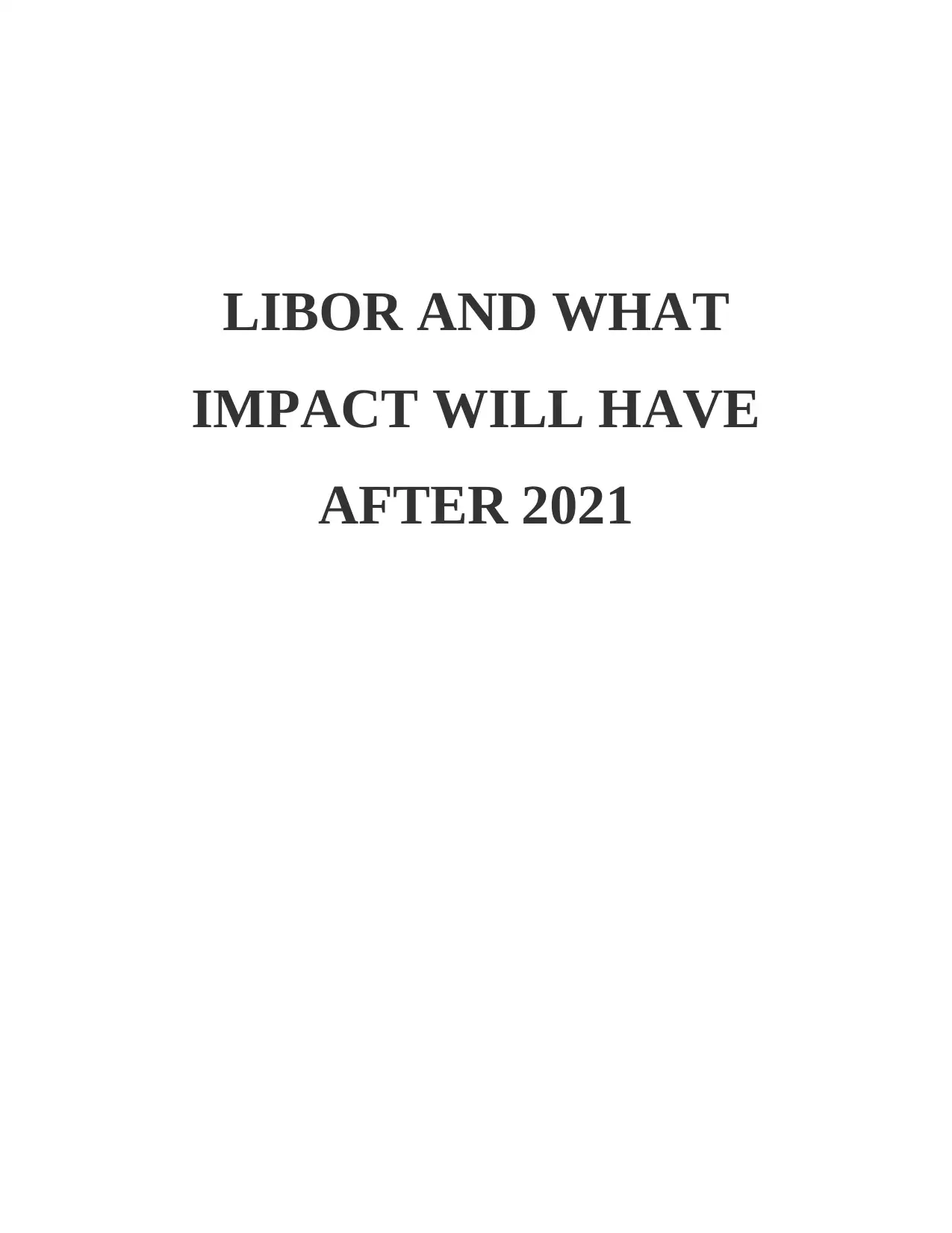
LIBOR AND WHAT
IMPACT WILL HAVE
AFTER 2021
IMPACT WILL HAVE
AFTER 2021
Secure Best Marks with AI Grader
Need help grading? Try our AI Grader for instant feedback on your assignments.
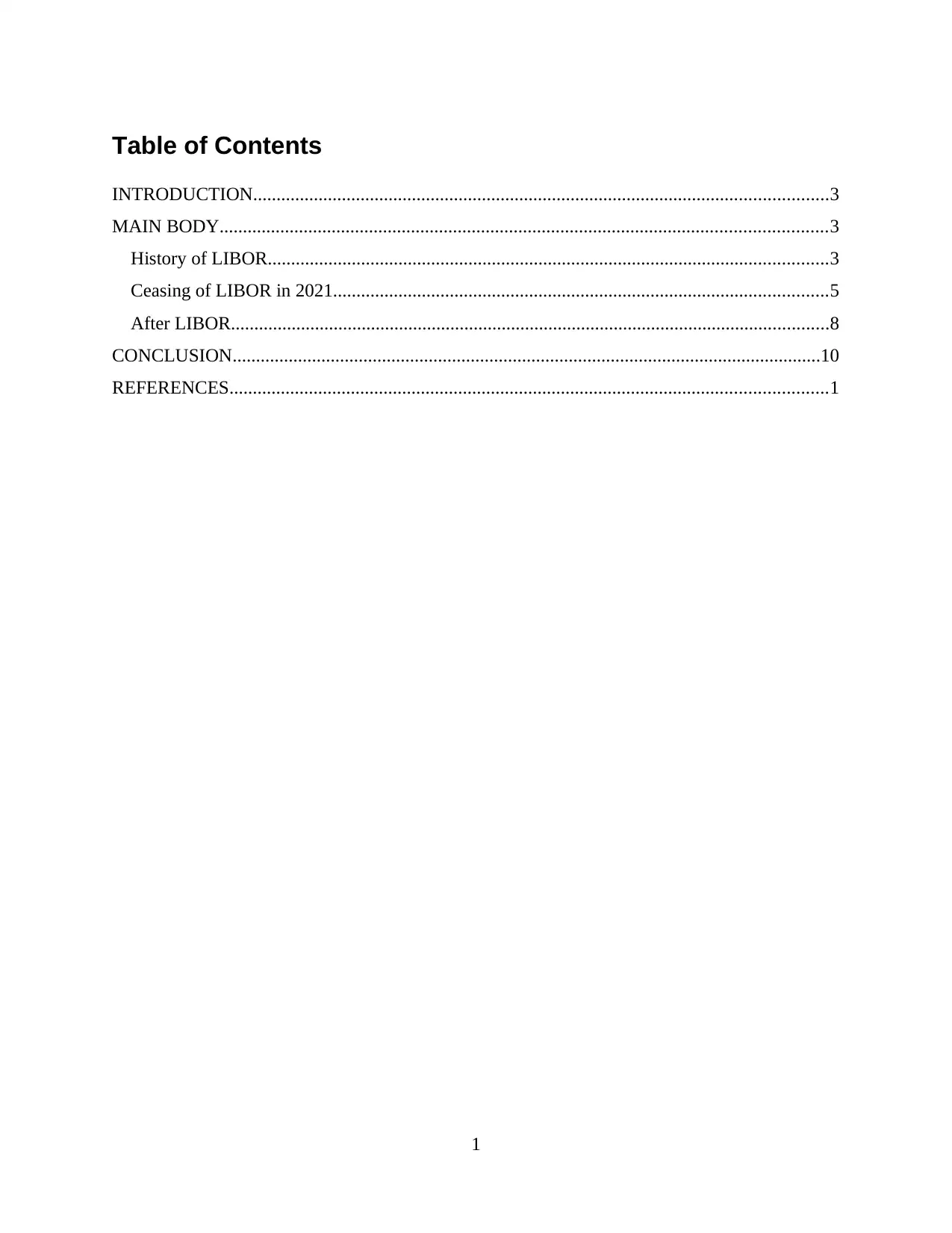
Table of Contents
INTRODUCTION...........................................................................................................................3
MAIN BODY..................................................................................................................................3
History of LIBOR........................................................................................................................3
Ceasing of LIBOR in 2021..........................................................................................................5
After LIBOR................................................................................................................................8
CONCLUSION..............................................................................................................................10
REFERENCES................................................................................................................................1
1
INTRODUCTION...........................................................................................................................3
MAIN BODY..................................................................................................................................3
History of LIBOR........................................................................................................................3
Ceasing of LIBOR in 2021..........................................................................................................5
After LIBOR................................................................................................................................8
CONCLUSION..............................................................................................................................10
REFERENCES................................................................................................................................1
1
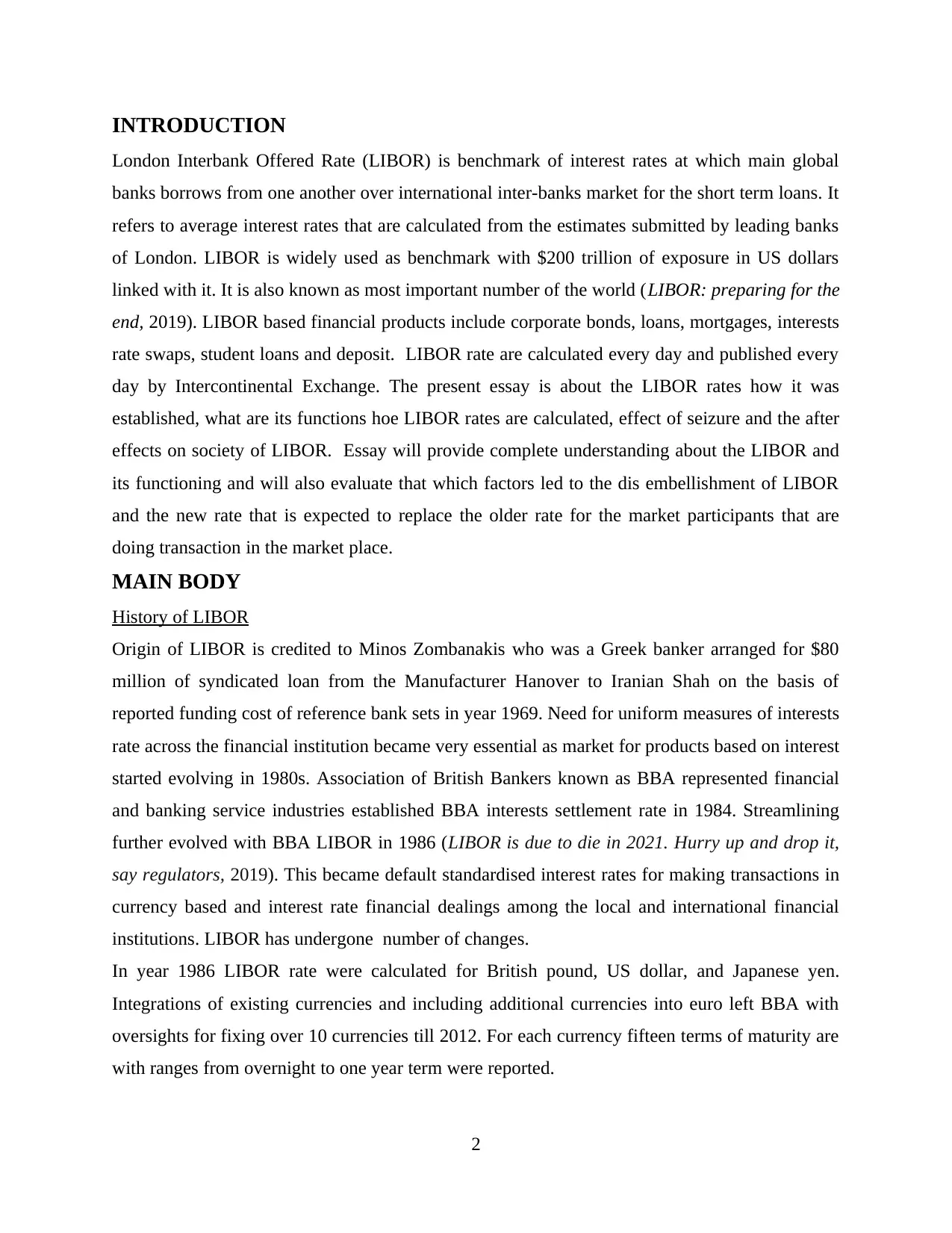
INTRODUCTION
London Interbank Offered Rate (LIBOR) is benchmark of interest rates at which main global
banks borrows from one another over international inter-banks market for the short term loans. It
refers to average interest rates that are calculated from the estimates submitted by leading banks
of London. LIBOR is widely used as benchmark with $200 trillion of exposure in US dollars
linked with it. It is also known as most important number of the world (LIBOR: preparing for the
end, 2019). LIBOR based financial products include corporate bonds, loans, mortgages, interests
rate swaps, student loans and deposit. LIBOR rate are calculated every day and published every
day by Intercontinental Exchange. The present essay is about the LIBOR rates how it was
established, what are its functions hoe LIBOR rates are calculated, effect of seizure and the after
effects on society of LIBOR. Essay will provide complete understanding about the LIBOR and
its functioning and will also evaluate that which factors led to the dis embellishment of LIBOR
and the new rate that is expected to replace the older rate for the market participants that are
doing transaction in the market place.
MAIN BODY
History of LIBOR
Origin of LIBOR is credited to Minos Zombanakis who was a Greek banker arranged for $80
million of syndicated loan from the Manufacturer Hanover to Iranian Shah on the basis of
reported funding cost of reference bank sets in year 1969. Need for uniform measures of interests
rate across the financial institution became very essential as market for products based on interest
started evolving in 1980s. Association of British Bankers known as BBA represented financial
and banking service industries established BBA interests settlement rate in 1984. Streamlining
further evolved with BBA LIBOR in 1986 (LIBOR is due to die in 2021. Hurry up and drop it,
say regulators, 2019). This became default standardised interest rates for making transactions in
currency based and interest rate financial dealings among the local and international financial
institutions. LIBOR has undergone number of changes.
In year 1986 LIBOR rate were calculated for British pound, US dollar, and Japanese yen.
Integrations of existing currencies and including additional currencies into euro left BBA with
oversights for fixing over 10 currencies till 2012. For each currency fifteen terms of maturity are
with ranges from overnight to one year term were reported.
2
London Interbank Offered Rate (LIBOR) is benchmark of interest rates at which main global
banks borrows from one another over international inter-banks market for the short term loans. It
refers to average interest rates that are calculated from the estimates submitted by leading banks
of London. LIBOR is widely used as benchmark with $200 trillion of exposure in US dollars
linked with it. It is also known as most important number of the world (LIBOR: preparing for the
end, 2019). LIBOR based financial products include corporate bonds, loans, mortgages, interests
rate swaps, student loans and deposit. LIBOR rate are calculated every day and published every
day by Intercontinental Exchange. The present essay is about the LIBOR rates how it was
established, what are its functions hoe LIBOR rates are calculated, effect of seizure and the after
effects on society of LIBOR. Essay will provide complete understanding about the LIBOR and
its functioning and will also evaluate that which factors led to the dis embellishment of LIBOR
and the new rate that is expected to replace the older rate for the market participants that are
doing transaction in the market place.
MAIN BODY
History of LIBOR
Origin of LIBOR is credited to Minos Zombanakis who was a Greek banker arranged for $80
million of syndicated loan from the Manufacturer Hanover to Iranian Shah on the basis of
reported funding cost of reference bank sets in year 1969. Need for uniform measures of interests
rate across the financial institution became very essential as market for products based on interest
started evolving in 1980s. Association of British Bankers known as BBA represented financial
and banking service industries established BBA interests settlement rate in 1984. Streamlining
further evolved with BBA LIBOR in 1986 (LIBOR is due to die in 2021. Hurry up and drop it,
say regulators, 2019). This became default standardised interest rates for making transactions in
currency based and interest rate financial dealings among the local and international financial
institutions. LIBOR has undergone number of changes.
In year 1986 LIBOR rate were calculated for British pound, US dollar, and Japanese yen.
Integrations of existing currencies and including additional currencies into euro left BBA with
oversights for fixing over 10 currencies till 2012. For each currency fifteen terms of maturity are
with ranges from overnight to one year term were reported.
2
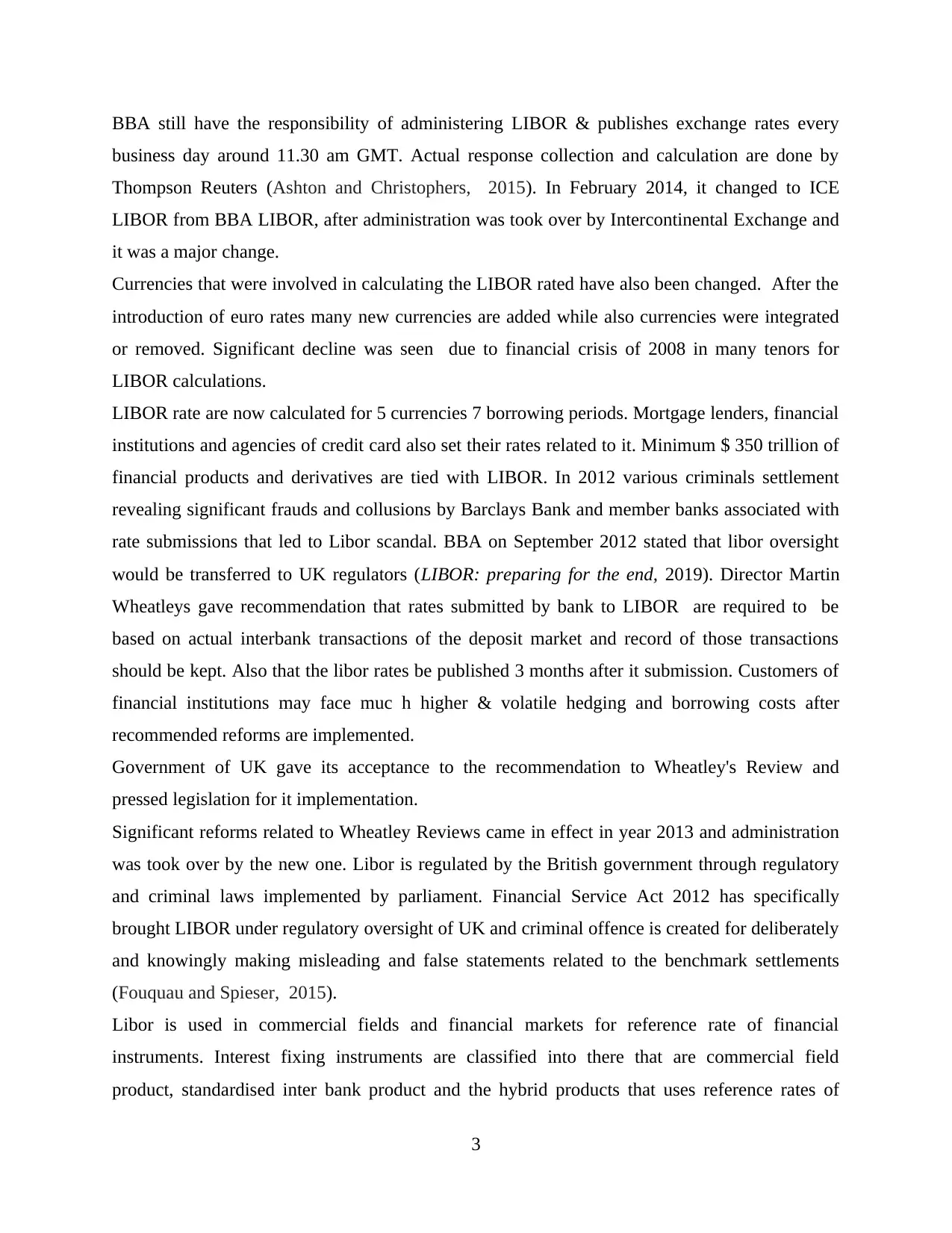
BBA still have the responsibility of administering LIBOR & publishes exchange rates every
business day around 11.30 am GMT. Actual response collection and calculation are done by
Thompson Reuters (Ashton and Christophers, 2015). In February 2014, it changed to ICE
LIBOR from BBA LIBOR, after administration was took over by Intercontinental Exchange and
it was a major change.
Currencies that were involved in calculating the LIBOR rated have also been changed. After the
introduction of euro rates many new currencies are added while also currencies were integrated
or removed. Significant decline was seen due to financial crisis of 2008 in many tenors for
LIBOR calculations.
LIBOR rate are now calculated for 5 currencies 7 borrowing periods. Mortgage lenders, financial
institutions and agencies of credit card also set their rates related to it. Minimum $ 350 trillion of
financial products and derivatives are tied with LIBOR. In 2012 various criminals settlement
revealing significant frauds and collusions by Barclays Bank and member banks associated with
rate submissions that led to Libor scandal. BBA on September 2012 stated that libor oversight
would be transferred to UK regulators (LIBOR: preparing for the end, 2019). Director Martin
Wheatleys gave recommendation that rates submitted by bank to LIBOR are required to be
based on actual interbank transactions of the deposit market and record of those transactions
should be kept. Also that the libor rates be published 3 months after it submission. Customers of
financial institutions may face muc h higher & volatile hedging and borrowing costs after
recommended reforms are implemented.
Government of UK gave its acceptance to the recommendation to Wheatley's Review and
pressed legislation for it implementation.
Significant reforms related to Wheatley Reviews came in effect in year 2013 and administration
was took over by the new one. Libor is regulated by the British government through regulatory
and criminal laws implemented by parliament. Financial Service Act 2012 has specifically
brought LIBOR under regulatory oversight of UK and criminal offence is created for deliberately
and knowingly making misleading and false statements related to the benchmark settlements
(Fouquau and Spieser, 2015).
Libor is used in commercial fields and financial markets for reference rate of financial
instruments. Interest fixing instruments are classified into there that are commercial field
product, standardised inter bank product and the hybrid products that uses reference rates of
3
business day around 11.30 am GMT. Actual response collection and calculation are done by
Thompson Reuters (Ashton and Christophers, 2015). In February 2014, it changed to ICE
LIBOR from BBA LIBOR, after administration was took over by Intercontinental Exchange and
it was a major change.
Currencies that were involved in calculating the LIBOR rated have also been changed. After the
introduction of euro rates many new currencies are added while also currencies were integrated
or removed. Significant decline was seen due to financial crisis of 2008 in many tenors for
LIBOR calculations.
LIBOR rate are now calculated for 5 currencies 7 borrowing periods. Mortgage lenders, financial
institutions and agencies of credit card also set their rates related to it. Minimum $ 350 trillion of
financial products and derivatives are tied with LIBOR. In 2012 various criminals settlement
revealing significant frauds and collusions by Barclays Bank and member banks associated with
rate submissions that led to Libor scandal. BBA on September 2012 stated that libor oversight
would be transferred to UK regulators (LIBOR: preparing for the end, 2019). Director Martin
Wheatleys gave recommendation that rates submitted by bank to LIBOR are required to be
based on actual interbank transactions of the deposit market and record of those transactions
should be kept. Also that the libor rates be published 3 months after it submission. Customers of
financial institutions may face muc h higher & volatile hedging and borrowing costs after
recommended reforms are implemented.
Government of UK gave its acceptance to the recommendation to Wheatley's Review and
pressed legislation for it implementation.
Significant reforms related to Wheatley Reviews came in effect in year 2013 and administration
was took over by the new one. Libor is regulated by the British government through regulatory
and criminal laws implemented by parliament. Financial Service Act 2012 has specifically
brought LIBOR under regulatory oversight of UK and criminal offence is created for deliberately
and knowingly making misleading and false statements related to the benchmark settlements
(Fouquau and Spieser, 2015).
Libor is used in commercial fields and financial markets for reference rate of financial
instruments. Interest fixing instruments are classified into there that are commercial field
product, standardised inter bank product and the hybrid products that uses reference rates of
3
Secure Best Marks with AI Grader
Need help grading? Try our AI Grader for instant feedback on your assignments.
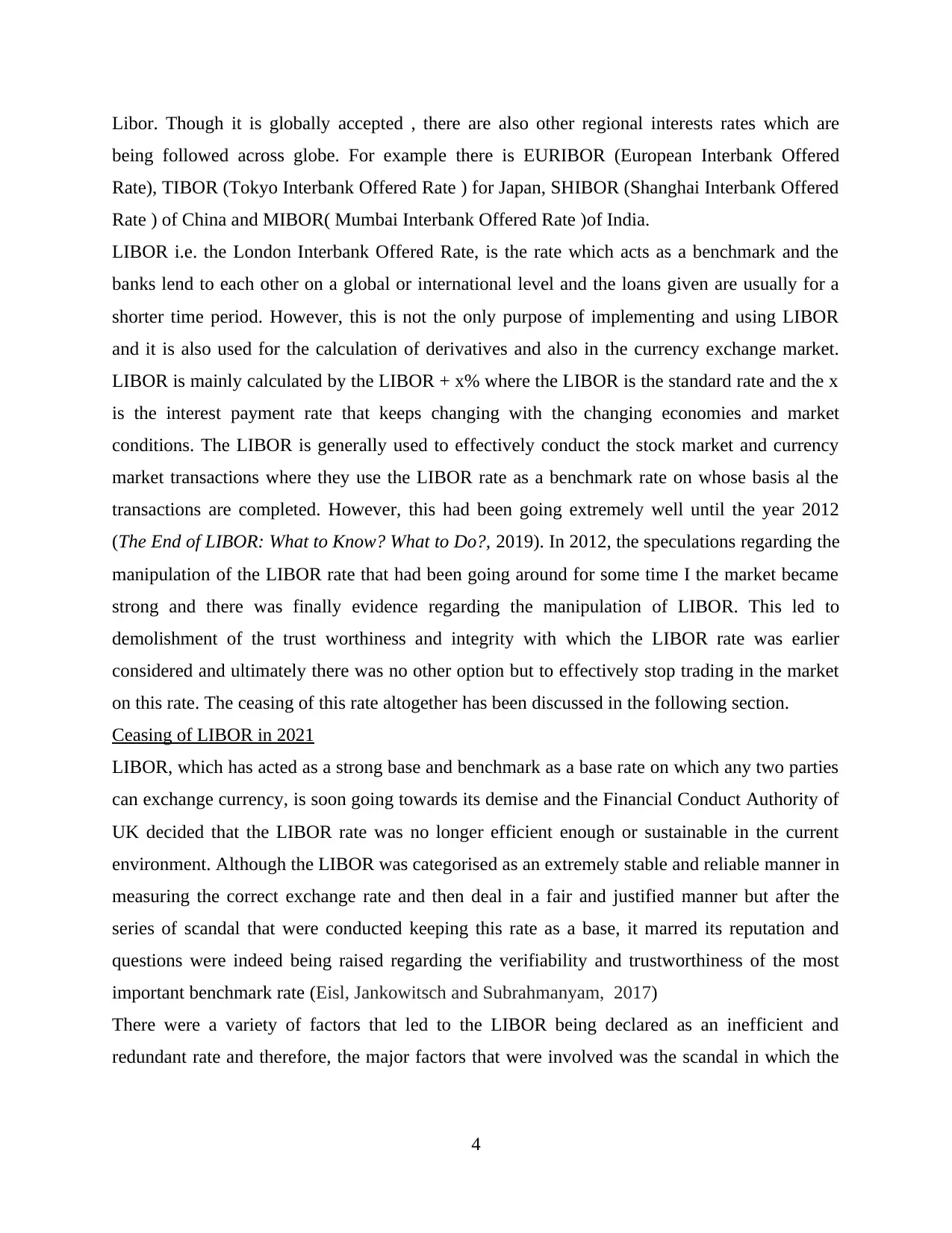
Libor. Though it is globally accepted , there are also other regional interests rates which are
being followed across globe. For example there is EURIBOR (European Interbank Offered
Rate), TIBOR (Tokyo Interbank Offered Rate ) for Japan, SHIBOR (Shanghai Interbank Offered
Rate ) of China and MIBOR( Mumbai Interbank Offered Rate )of India.
LIBOR i.e. the London Interbank Offered Rate, is the rate which acts as a benchmark and the
banks lend to each other on a global or international level and the loans given are usually for a
shorter time period. However, this is not the only purpose of implementing and using LIBOR
and it is also used for the calculation of derivatives and also in the currency exchange market.
LIBOR is mainly calculated by the LIBOR + x% where the LIBOR is the standard rate and the x
is the interest payment rate that keeps changing with the changing economies and market
conditions. The LIBOR is generally used to effectively conduct the stock market and currency
market transactions where they use the LIBOR rate as a benchmark rate on whose basis al the
transactions are completed. However, this had been going extremely well until the year 2012
(The End of LIBOR: What to Know? What to Do?, 2019). In 2012, the speculations regarding the
manipulation of the LIBOR rate that had been going around for some time I the market became
strong and there was finally evidence regarding the manipulation of LIBOR. This led to
demolishment of the trust worthiness and integrity with which the LIBOR rate was earlier
considered and ultimately there was no other option but to effectively stop trading in the market
on this rate. The ceasing of this rate altogether has been discussed in the following section.
Ceasing of LIBOR in 2021
LIBOR, which has acted as a strong base and benchmark as a base rate on which any two parties
can exchange currency, is soon going towards its demise and the Financial Conduct Authority of
UK decided that the LIBOR rate was no longer efficient enough or sustainable in the current
environment. Although the LIBOR was categorised as an extremely stable and reliable manner in
measuring the correct exchange rate and then deal in a fair and justified manner but after the
series of scandal that were conducted keeping this rate as a base, it marred its reputation and
questions were indeed being raised regarding the verifiability and trustworthiness of the most
important benchmark rate (Eisl, Jankowitsch and Subrahmanyam, 2017)
There were a variety of factors that led to the LIBOR being declared as an inefficient and
redundant rate and therefore, the major factors that were involved was the scandal in which the
4
being followed across globe. For example there is EURIBOR (European Interbank Offered
Rate), TIBOR (Tokyo Interbank Offered Rate ) for Japan, SHIBOR (Shanghai Interbank Offered
Rate ) of China and MIBOR( Mumbai Interbank Offered Rate )of India.
LIBOR i.e. the London Interbank Offered Rate, is the rate which acts as a benchmark and the
banks lend to each other on a global or international level and the loans given are usually for a
shorter time period. However, this is not the only purpose of implementing and using LIBOR
and it is also used for the calculation of derivatives and also in the currency exchange market.
LIBOR is mainly calculated by the LIBOR + x% where the LIBOR is the standard rate and the x
is the interest payment rate that keeps changing with the changing economies and market
conditions. The LIBOR is generally used to effectively conduct the stock market and currency
market transactions where they use the LIBOR rate as a benchmark rate on whose basis al the
transactions are completed. However, this had been going extremely well until the year 2012
(The End of LIBOR: What to Know? What to Do?, 2019). In 2012, the speculations regarding the
manipulation of the LIBOR rate that had been going around for some time I the market became
strong and there was finally evidence regarding the manipulation of LIBOR. This led to
demolishment of the trust worthiness and integrity with which the LIBOR rate was earlier
considered and ultimately there was no other option but to effectively stop trading in the market
on this rate. The ceasing of this rate altogether has been discussed in the following section.
Ceasing of LIBOR in 2021
LIBOR, which has acted as a strong base and benchmark as a base rate on which any two parties
can exchange currency, is soon going towards its demise and the Financial Conduct Authority of
UK decided that the LIBOR rate was no longer efficient enough or sustainable in the current
environment. Although the LIBOR was categorised as an extremely stable and reliable manner in
measuring the correct exchange rate and then deal in a fair and justified manner but after the
series of scandal that were conducted keeping this rate as a base, it marred its reputation and
questions were indeed being raised regarding the verifiability and trustworthiness of the most
important benchmark rate (Eisl, Jankowitsch and Subrahmanyam, 2017)
There were a variety of factors that led to the LIBOR being declared as an inefficient and
redundant rate and therefore, the major factors that were involved was the scandal in which the
4
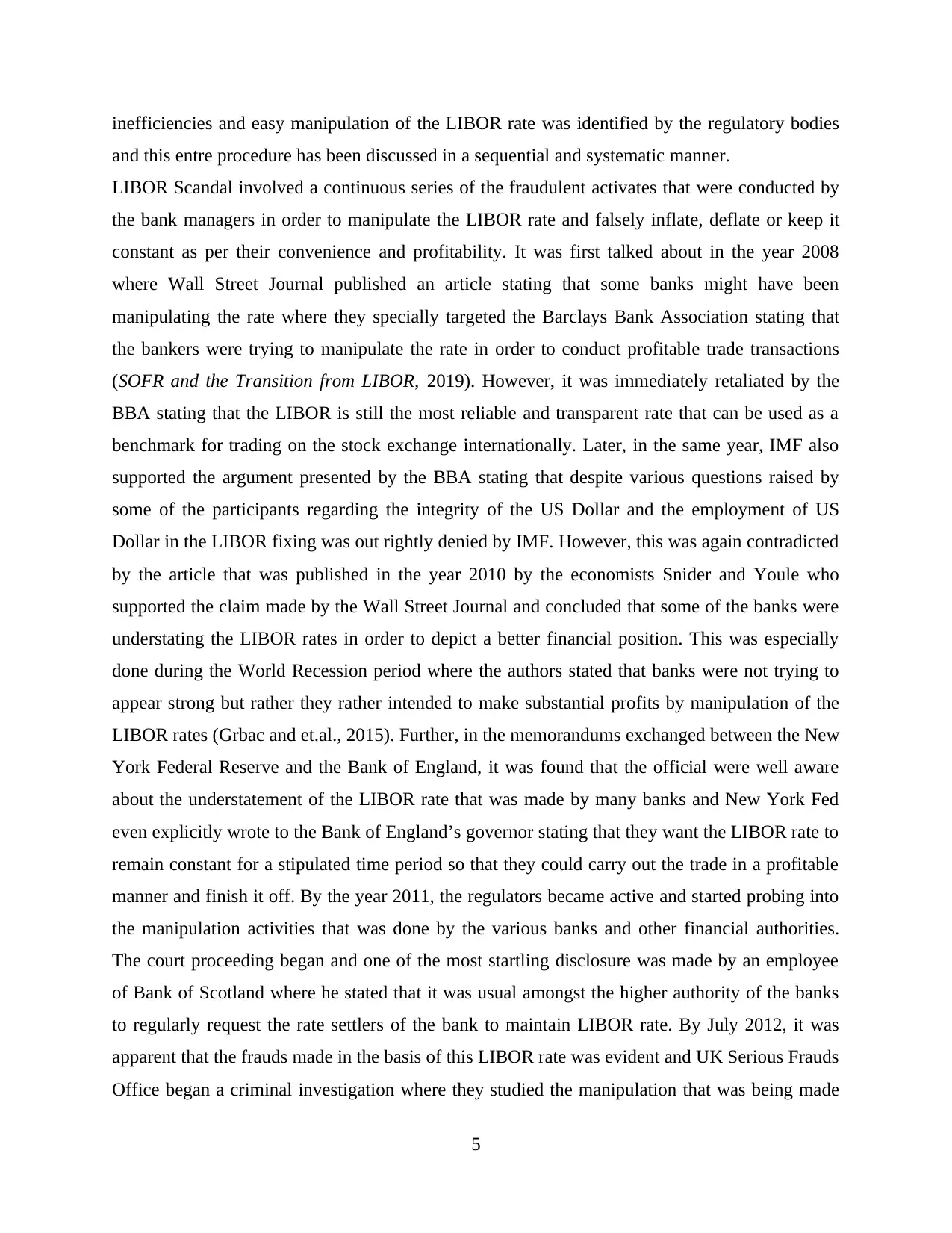
inefficiencies and easy manipulation of the LIBOR rate was identified by the regulatory bodies
and this entre procedure has been discussed in a sequential and systematic manner.
LIBOR Scandal involved a continuous series of the fraudulent activates that were conducted by
the bank managers in order to manipulate the LIBOR rate and falsely inflate, deflate or keep it
constant as per their convenience and profitability. It was first talked about in the year 2008
where Wall Street Journal published an article stating that some banks might have been
manipulating the rate where they specially targeted the Barclays Bank Association stating that
the bankers were trying to manipulate the rate in order to conduct profitable trade transactions
(SOFR and the Transition from LIBOR, 2019). However, it was immediately retaliated by the
BBA stating that the LIBOR is still the most reliable and transparent rate that can be used as a
benchmark for trading on the stock exchange internationally. Later, in the same year, IMF also
supported the argument presented by the BBA stating that despite various questions raised by
some of the participants regarding the integrity of the US Dollar and the employment of US
Dollar in the LIBOR fixing was out rightly denied by IMF. However, this was again contradicted
by the article that was published in the year 2010 by the economists Snider and Youle who
supported the claim made by the Wall Street Journal and concluded that some of the banks were
understating the LIBOR rates in order to depict a better financial position. This was especially
done during the World Recession period where the authors stated that banks were not trying to
appear strong but rather they rather intended to make substantial profits by manipulation of the
LIBOR rates (Grbac and et.al., 2015). Further, in the memorandums exchanged between the New
York Federal Reserve and the Bank of England, it was found that the official were well aware
about the understatement of the LIBOR rate that was made by many banks and New York Fed
even explicitly wrote to the Bank of England’s governor stating that they want the LIBOR rate to
remain constant for a stipulated time period so that they could carry out the trade in a profitable
manner and finish it off. By the year 2011, the regulators became active and started probing into
the manipulation activities that was done by the various banks and other financial authorities.
The court proceeding began and one of the most startling disclosure was made by an employee
of Bank of Scotland where he stated that it was usual amongst the higher authority of the banks
to regularly request the rate settlers of the bank to maintain LIBOR rate. By July 2012, it was
apparent that the frauds made in the basis of this LIBOR rate was evident and UK Serious Frauds
Office began a criminal investigation where they studied the manipulation that was being made
5
and this entre procedure has been discussed in a sequential and systematic manner.
LIBOR Scandal involved a continuous series of the fraudulent activates that were conducted by
the bank managers in order to manipulate the LIBOR rate and falsely inflate, deflate or keep it
constant as per their convenience and profitability. It was first talked about in the year 2008
where Wall Street Journal published an article stating that some banks might have been
manipulating the rate where they specially targeted the Barclays Bank Association stating that
the bankers were trying to manipulate the rate in order to conduct profitable trade transactions
(SOFR and the Transition from LIBOR, 2019). However, it was immediately retaliated by the
BBA stating that the LIBOR is still the most reliable and transparent rate that can be used as a
benchmark for trading on the stock exchange internationally. Later, in the same year, IMF also
supported the argument presented by the BBA stating that despite various questions raised by
some of the participants regarding the integrity of the US Dollar and the employment of US
Dollar in the LIBOR fixing was out rightly denied by IMF. However, this was again contradicted
by the article that was published in the year 2010 by the economists Snider and Youle who
supported the claim made by the Wall Street Journal and concluded that some of the banks were
understating the LIBOR rates in order to depict a better financial position. This was especially
done during the World Recession period where the authors stated that banks were not trying to
appear strong but rather they rather intended to make substantial profits by manipulation of the
LIBOR rates (Grbac and et.al., 2015). Further, in the memorandums exchanged between the New
York Federal Reserve and the Bank of England, it was found that the official were well aware
about the understatement of the LIBOR rate that was made by many banks and New York Fed
even explicitly wrote to the Bank of England’s governor stating that they want the LIBOR rate to
remain constant for a stipulated time period so that they could carry out the trade in a profitable
manner and finish it off. By the year 2011, the regulators became active and started probing into
the manipulation activities that was done by the various banks and other financial authorities.
The court proceeding began and one of the most startling disclosure was made by an employee
of Bank of Scotland where he stated that it was usual amongst the higher authority of the banks
to regularly request the rate settlers of the bank to maintain LIBOR rate. By July 2012, it was
apparent that the frauds made in the basis of this LIBOR rate was evident and UK Serious Frauds
Office began a criminal investigation where they studied the manipulation that was being made
5
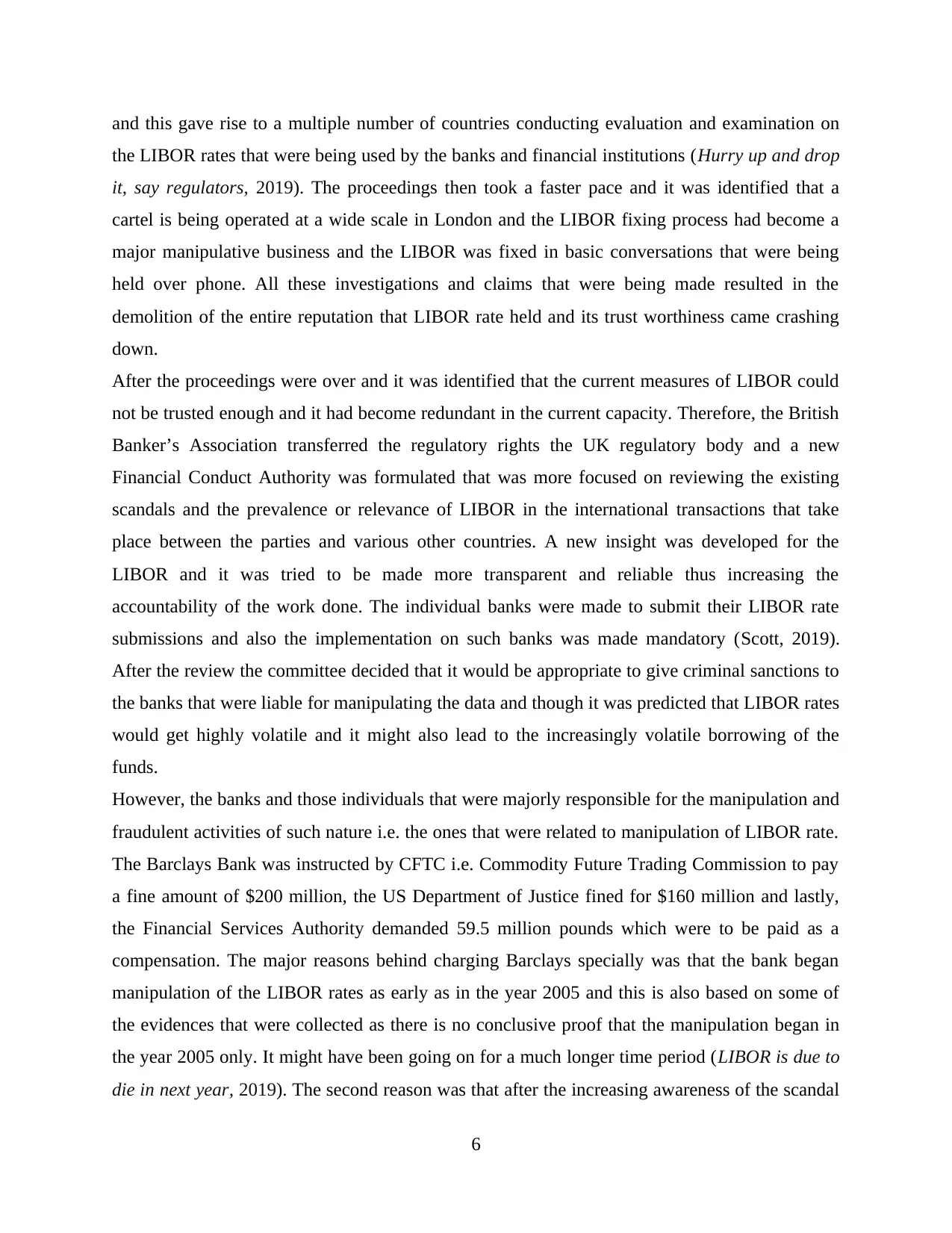
and this gave rise to a multiple number of countries conducting evaluation and examination on
the LIBOR rates that were being used by the banks and financial institutions (Hurry up and drop
it, say regulators, 2019). The proceedings then took a faster pace and it was identified that a
cartel is being operated at a wide scale in London and the LIBOR fixing process had become a
major manipulative business and the LIBOR was fixed in basic conversations that were being
held over phone. All these investigations and claims that were being made resulted in the
demolition of the entire reputation that LIBOR rate held and its trust worthiness came crashing
down.
After the proceedings were over and it was identified that the current measures of LIBOR could
not be trusted enough and it had become redundant in the current capacity. Therefore, the British
Banker’s Association transferred the regulatory rights the UK regulatory body and a new
Financial Conduct Authority was formulated that was more focused on reviewing the existing
scandals and the prevalence or relevance of LIBOR in the international transactions that take
place between the parties and various other countries. A new insight was developed for the
LIBOR and it was tried to be made more transparent and reliable thus increasing the
accountability of the work done. The individual banks were made to submit their LIBOR rate
submissions and also the implementation on such banks was made mandatory (Scott, 2019).
After the review the committee decided that it would be appropriate to give criminal sanctions to
the banks that were liable for manipulating the data and though it was predicted that LIBOR rates
would get highly volatile and it might also lead to the increasingly volatile borrowing of the
funds.
However, the banks and those individuals that were majorly responsible for the manipulation and
fraudulent activities of such nature i.e. the ones that were related to manipulation of LIBOR rate.
The Barclays Bank was instructed by CFTC i.e. Commodity Future Trading Commission to pay
a fine amount of $200 million, the US Department of Justice fined for $160 million and lastly,
the Financial Services Authority demanded 59.5 million pounds which were to be paid as a
compensation. The major reasons behind charging Barclays specially was that the bank began
manipulation of the LIBOR rates as early as in the year 2005 and this is also based on some of
the evidences that were collected as there is no conclusive proof that the manipulation began in
the year 2005 only. It might have been going on for a much longer time period (LIBOR is due to
die in next year, 2019). The second reason was that after the increasing awareness of the scandal
6
the LIBOR rates that were being used by the banks and financial institutions (Hurry up and drop
it, say regulators, 2019). The proceedings then took a faster pace and it was identified that a
cartel is being operated at a wide scale in London and the LIBOR fixing process had become a
major manipulative business and the LIBOR was fixed in basic conversations that were being
held over phone. All these investigations and claims that were being made resulted in the
demolition of the entire reputation that LIBOR rate held and its trust worthiness came crashing
down.
After the proceedings were over and it was identified that the current measures of LIBOR could
not be trusted enough and it had become redundant in the current capacity. Therefore, the British
Banker’s Association transferred the regulatory rights the UK regulatory body and a new
Financial Conduct Authority was formulated that was more focused on reviewing the existing
scandals and the prevalence or relevance of LIBOR in the international transactions that take
place between the parties and various other countries. A new insight was developed for the
LIBOR and it was tried to be made more transparent and reliable thus increasing the
accountability of the work done. The individual banks were made to submit their LIBOR rate
submissions and also the implementation on such banks was made mandatory (Scott, 2019).
After the review the committee decided that it would be appropriate to give criminal sanctions to
the banks that were liable for manipulating the data and though it was predicted that LIBOR rates
would get highly volatile and it might also lead to the increasingly volatile borrowing of the
funds.
However, the banks and those individuals that were majorly responsible for the manipulation and
fraudulent activities of such nature i.e. the ones that were related to manipulation of LIBOR rate.
The Barclays Bank was instructed by CFTC i.e. Commodity Future Trading Commission to pay
a fine amount of $200 million, the US Department of Justice fined for $160 million and lastly,
the Financial Services Authority demanded 59.5 million pounds which were to be paid as a
compensation. The major reasons behind charging Barclays specially was that the bank began
manipulation of the LIBOR rates as early as in the year 2005 and this is also based on some of
the evidences that were collected as there is no conclusive proof that the manipulation began in
the year 2005 only. It might have been going on for a much longer time period (LIBOR is due to
die in next year, 2019). The second reason was that after the increasing awareness of the scandal
6
Paraphrase This Document
Need a fresh take? Get an instant paraphrase of this document with our AI Paraphraser
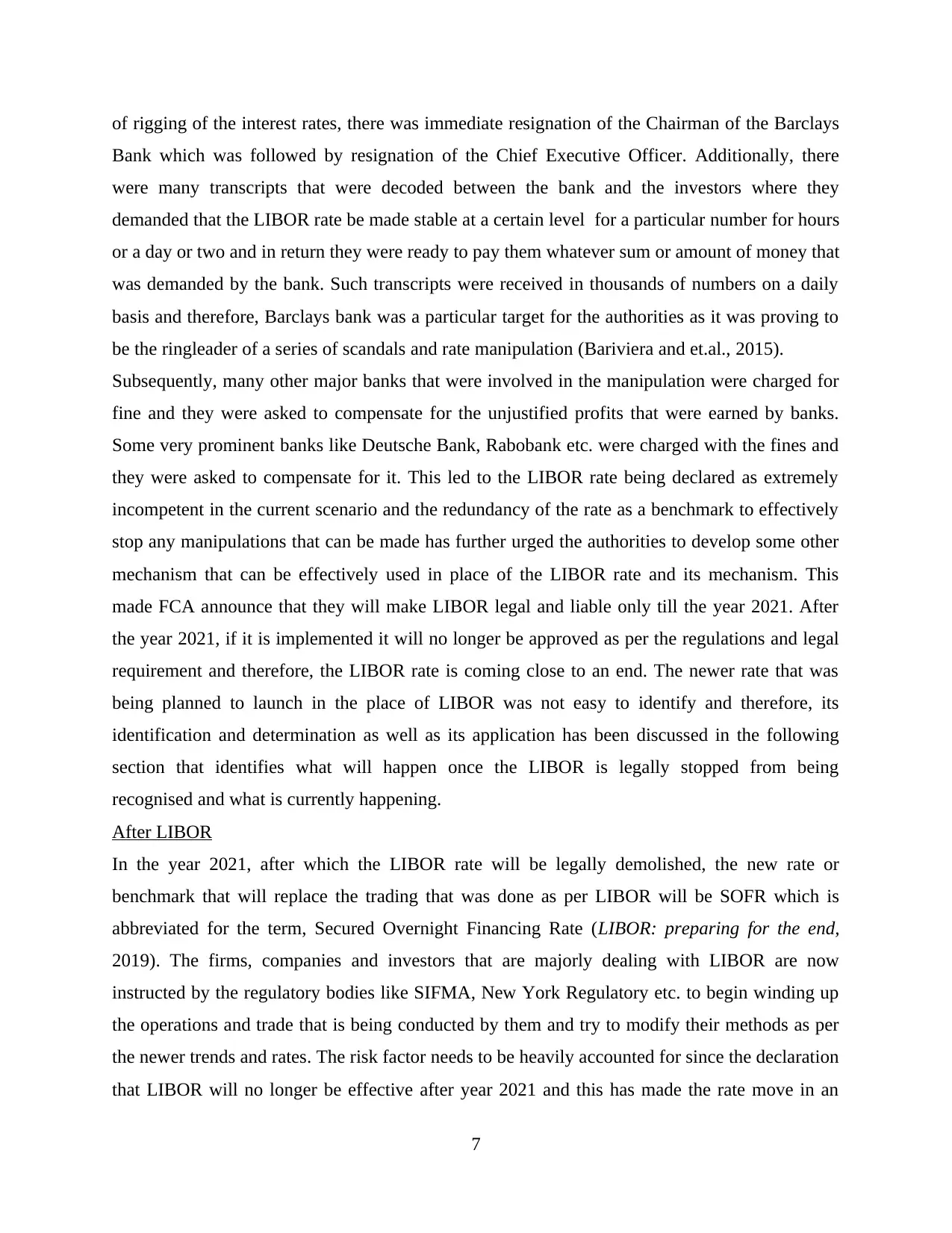
of rigging of the interest rates, there was immediate resignation of the Chairman of the Barclays
Bank which was followed by resignation of the Chief Executive Officer. Additionally, there
were many transcripts that were decoded between the bank and the investors where they
demanded that the LIBOR rate be made stable at a certain level for a particular number for hours
or a day or two and in return they were ready to pay them whatever sum or amount of money that
was demanded by the bank. Such transcripts were received in thousands of numbers on a daily
basis and therefore, Barclays bank was a particular target for the authorities as it was proving to
be the ringleader of a series of scandals and rate manipulation (Bariviera and et.al., 2015).
Subsequently, many other major banks that were involved in the manipulation were charged for
fine and they were asked to compensate for the unjustified profits that were earned by banks.
Some very prominent banks like Deutsche Bank, Rabobank etc. were charged with the fines and
they were asked to compensate for it. This led to the LIBOR rate being declared as extremely
incompetent in the current scenario and the redundancy of the rate as a benchmark to effectively
stop any manipulations that can be made has further urged the authorities to develop some other
mechanism that can be effectively used in place of the LIBOR rate and its mechanism. This
made FCA announce that they will make LIBOR legal and liable only till the year 2021. After
the year 2021, if it is implemented it will no longer be approved as per the regulations and legal
requirement and therefore, the LIBOR rate is coming close to an end. The newer rate that was
being planned to launch in the place of LIBOR was not easy to identify and therefore, its
identification and determination as well as its application has been discussed in the following
section that identifies what will happen once the LIBOR is legally stopped from being
recognised and what is currently happening.
After LIBOR
In the year 2021, after which the LIBOR rate will be legally demolished, the new rate or
benchmark that will replace the trading that was done as per LIBOR will be SOFR which is
abbreviated for the term, Secured Overnight Financing Rate (LIBOR: preparing for the end,
2019). The firms, companies and investors that are majorly dealing with LIBOR are now
instructed by the regulatory bodies like SIFMA, New York Regulatory etc. to begin winding up
the operations and trade that is being conducted by them and try to modify their methods as per
the newer trends and rates. The risk factor needs to be heavily accounted for since the declaration
that LIBOR will no longer be effective after year 2021 and this has made the rate move in an
7
Bank which was followed by resignation of the Chief Executive Officer. Additionally, there
were many transcripts that were decoded between the bank and the investors where they
demanded that the LIBOR rate be made stable at a certain level for a particular number for hours
or a day or two and in return they were ready to pay them whatever sum or amount of money that
was demanded by the bank. Such transcripts were received in thousands of numbers on a daily
basis and therefore, Barclays bank was a particular target for the authorities as it was proving to
be the ringleader of a series of scandals and rate manipulation (Bariviera and et.al., 2015).
Subsequently, many other major banks that were involved in the manipulation were charged for
fine and they were asked to compensate for the unjustified profits that were earned by banks.
Some very prominent banks like Deutsche Bank, Rabobank etc. were charged with the fines and
they were asked to compensate for it. This led to the LIBOR rate being declared as extremely
incompetent in the current scenario and the redundancy of the rate as a benchmark to effectively
stop any manipulations that can be made has further urged the authorities to develop some other
mechanism that can be effectively used in place of the LIBOR rate and its mechanism. This
made FCA announce that they will make LIBOR legal and liable only till the year 2021. After
the year 2021, if it is implemented it will no longer be approved as per the regulations and legal
requirement and therefore, the LIBOR rate is coming close to an end. The newer rate that was
being planned to launch in the place of LIBOR was not easy to identify and therefore, its
identification and determination as well as its application has been discussed in the following
section that identifies what will happen once the LIBOR is legally stopped from being
recognised and what is currently happening.
After LIBOR
In the year 2021, after which the LIBOR rate will be legally demolished, the new rate or
benchmark that will replace the trading that was done as per LIBOR will be SOFR which is
abbreviated for the term, Secured Overnight Financing Rate (LIBOR: preparing for the end,
2019). The firms, companies and investors that are majorly dealing with LIBOR are now
instructed by the regulatory bodies like SIFMA, New York Regulatory etc. to begin winding up
the operations and trade that is being conducted by them and try to modify their methods as per
the newer trends and rates. The risk factor needs to be heavily accounted for since the declaration
that LIBOR will no longer be effective after year 2021 and this has made the rate move in an
7
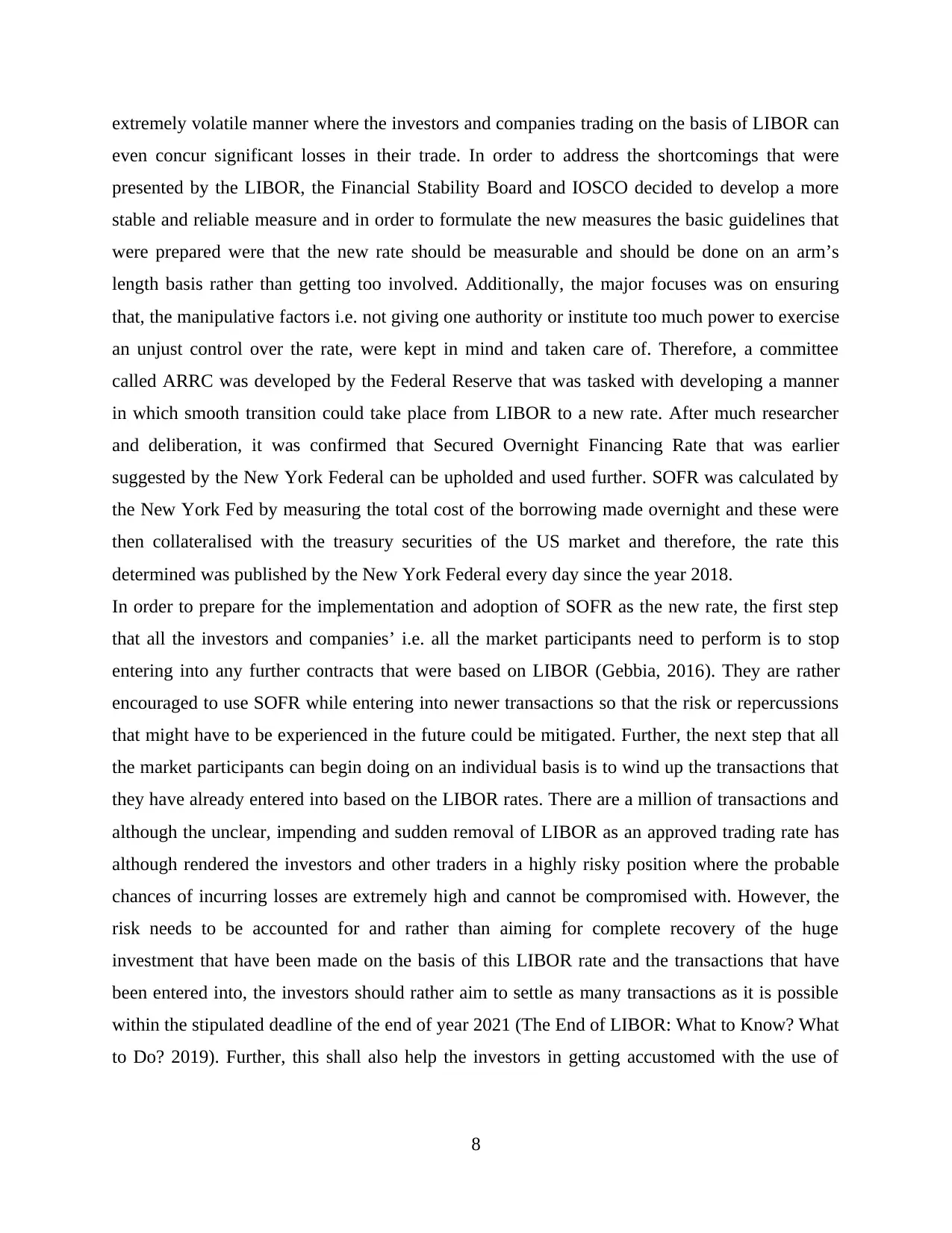
extremely volatile manner where the investors and companies trading on the basis of LIBOR can
even concur significant losses in their trade. In order to address the shortcomings that were
presented by the LIBOR, the Financial Stability Board and IOSCO decided to develop a more
stable and reliable measure and in order to formulate the new measures the basic guidelines that
were prepared were that the new rate should be measurable and should be done on an arm’s
length basis rather than getting too involved. Additionally, the major focuses was on ensuring
that, the manipulative factors i.e. not giving one authority or institute too much power to exercise
an unjust control over the rate, were kept in mind and taken care of. Therefore, a committee
called ARRC was developed by the Federal Reserve that was tasked with developing a manner
in which smooth transition could take place from LIBOR to a new rate. After much researcher
and deliberation, it was confirmed that Secured Overnight Financing Rate that was earlier
suggested by the New York Federal can be upholded and used further. SOFR was calculated by
the New York Fed by measuring the total cost of the borrowing made overnight and these were
then collateralised with the treasury securities of the US market and therefore, the rate this
determined was published by the New York Federal every day since the year 2018.
In order to prepare for the implementation and adoption of SOFR as the new rate, the first step
that all the investors and companies’ i.e. all the market participants need to perform is to stop
entering into any further contracts that were based on LIBOR (Gebbia, 2016). They are rather
encouraged to use SOFR while entering into newer transactions so that the risk or repercussions
that might have to be experienced in the future could be mitigated. Further, the next step that all
the market participants can begin doing on an individual basis is to wind up the transactions that
they have already entered into based on the LIBOR rates. There are a million of transactions and
although the unclear, impending and sudden removal of LIBOR as an approved trading rate has
although rendered the investors and other traders in a highly risky position where the probable
chances of incurring losses are extremely high and cannot be compromised with. However, the
risk needs to be accounted for and rather than aiming for complete recovery of the huge
investment that have been made on the basis of this LIBOR rate and the transactions that have
been entered into, the investors should rather aim to settle as many transactions as it is possible
within the stipulated deadline of the end of year 2021 (The End of LIBOR: What to Know? What
to Do? 2019). Further, this shall also help the investors in getting accustomed with the use of
8
even concur significant losses in their trade. In order to address the shortcomings that were
presented by the LIBOR, the Financial Stability Board and IOSCO decided to develop a more
stable and reliable measure and in order to formulate the new measures the basic guidelines that
were prepared were that the new rate should be measurable and should be done on an arm’s
length basis rather than getting too involved. Additionally, the major focuses was on ensuring
that, the manipulative factors i.e. not giving one authority or institute too much power to exercise
an unjust control over the rate, were kept in mind and taken care of. Therefore, a committee
called ARRC was developed by the Federal Reserve that was tasked with developing a manner
in which smooth transition could take place from LIBOR to a new rate. After much researcher
and deliberation, it was confirmed that Secured Overnight Financing Rate that was earlier
suggested by the New York Federal can be upholded and used further. SOFR was calculated by
the New York Fed by measuring the total cost of the borrowing made overnight and these were
then collateralised with the treasury securities of the US market and therefore, the rate this
determined was published by the New York Federal every day since the year 2018.
In order to prepare for the implementation and adoption of SOFR as the new rate, the first step
that all the investors and companies’ i.e. all the market participants need to perform is to stop
entering into any further contracts that were based on LIBOR (Gebbia, 2016). They are rather
encouraged to use SOFR while entering into newer transactions so that the risk or repercussions
that might have to be experienced in the future could be mitigated. Further, the next step that all
the market participants can begin doing on an individual basis is to wind up the transactions that
they have already entered into based on the LIBOR rates. There are a million of transactions and
although the unclear, impending and sudden removal of LIBOR as an approved trading rate has
although rendered the investors and other traders in a highly risky position where the probable
chances of incurring losses are extremely high and cannot be compromised with. However, the
risk needs to be accounted for and rather than aiming for complete recovery of the huge
investment that have been made on the basis of this LIBOR rate and the transactions that have
been entered into, the investors should rather aim to settle as many transactions as it is possible
within the stipulated deadline of the end of year 2021 (The End of LIBOR: What to Know? What
to Do? 2019). Further, this shall also help the investors in getting accustomed with the use of
8
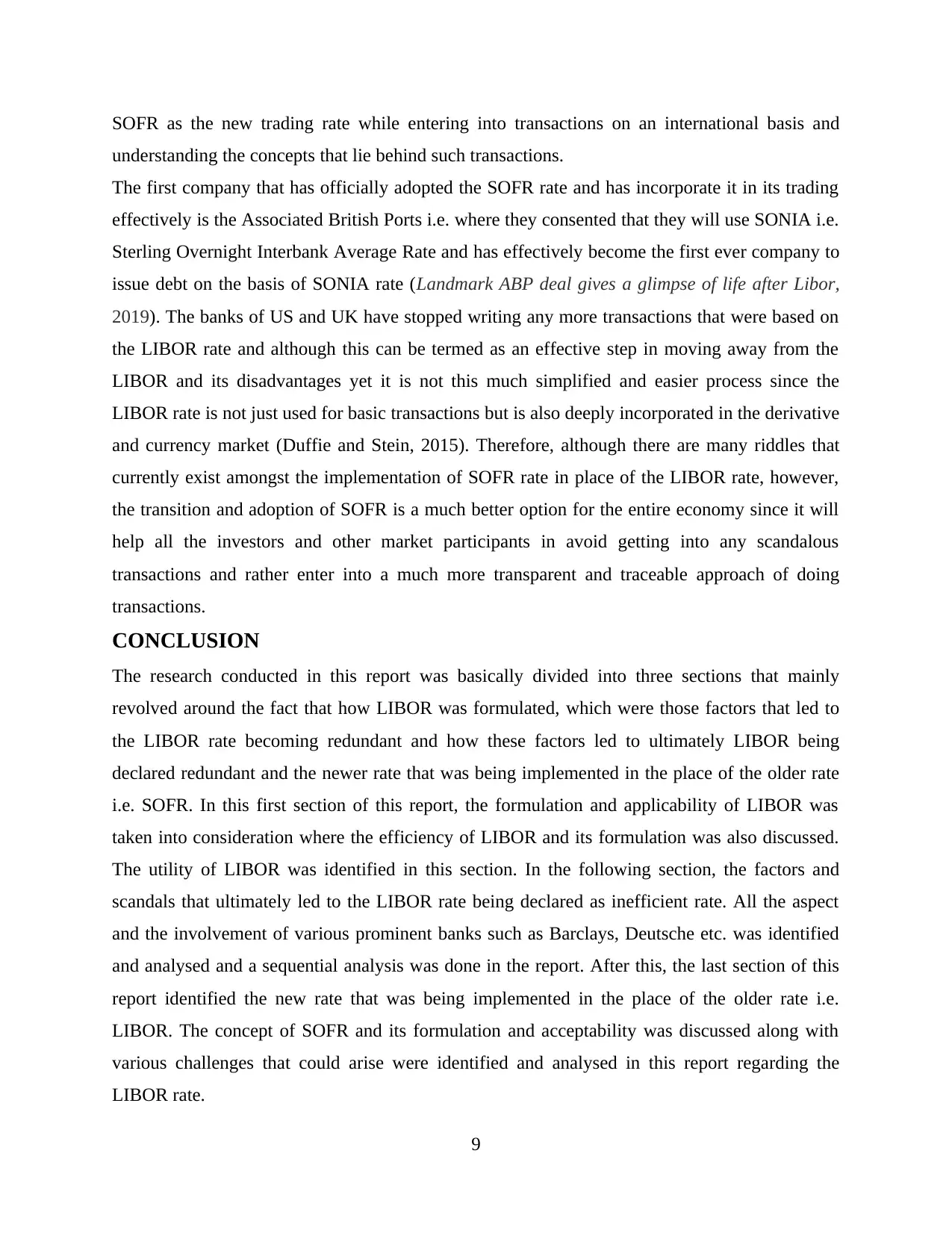
SOFR as the new trading rate while entering into transactions on an international basis and
understanding the concepts that lie behind such transactions.
The first company that has officially adopted the SOFR rate and has incorporate it in its trading
effectively is the Associated British Ports i.e. where they consented that they will use SONIA i.e.
Sterling Overnight Interbank Average Rate and has effectively become the first ever company to
issue debt on the basis of SONIA rate (Landmark ABP deal gives a glimpse of life after Libor,
2019). The banks of US and UK have stopped writing any more transactions that were based on
the LIBOR rate and although this can be termed as an effective step in moving away from the
LIBOR and its disadvantages yet it is not this much simplified and easier process since the
LIBOR rate is not just used for basic transactions but is also deeply incorporated in the derivative
and currency market (Duffie and Stein, 2015). Therefore, although there are many riddles that
currently exist amongst the implementation of SOFR rate in place of the LIBOR rate, however,
the transition and adoption of SOFR is a much better option for the entire economy since it will
help all the investors and other market participants in avoid getting into any scandalous
transactions and rather enter into a much more transparent and traceable approach of doing
transactions.
CONCLUSION
The research conducted in this report was basically divided into three sections that mainly
revolved around the fact that how LIBOR was formulated, which were those factors that led to
the LIBOR rate becoming redundant and how these factors led to ultimately LIBOR being
declared redundant and the newer rate that was being implemented in the place of the older rate
i.e. SOFR. In this first section of this report, the formulation and applicability of LIBOR was
taken into consideration where the efficiency of LIBOR and its formulation was also discussed.
The utility of LIBOR was identified in this section. In the following section, the factors and
scandals that ultimately led to the LIBOR rate being declared as inefficient rate. All the aspect
and the involvement of various prominent banks such as Barclays, Deutsche etc. was identified
and analysed and a sequential analysis was done in the report. After this, the last section of this
report identified the new rate that was being implemented in the place of the older rate i.e.
LIBOR. The concept of SOFR and its formulation and acceptability was discussed along with
various challenges that could arise were identified and analysed in this report regarding the
LIBOR rate.
9
understanding the concepts that lie behind such transactions.
The first company that has officially adopted the SOFR rate and has incorporate it in its trading
effectively is the Associated British Ports i.e. where they consented that they will use SONIA i.e.
Sterling Overnight Interbank Average Rate and has effectively become the first ever company to
issue debt on the basis of SONIA rate (Landmark ABP deal gives a glimpse of life after Libor,
2019). The banks of US and UK have stopped writing any more transactions that were based on
the LIBOR rate and although this can be termed as an effective step in moving away from the
LIBOR and its disadvantages yet it is not this much simplified and easier process since the
LIBOR rate is not just used for basic transactions but is also deeply incorporated in the derivative
and currency market (Duffie and Stein, 2015). Therefore, although there are many riddles that
currently exist amongst the implementation of SOFR rate in place of the LIBOR rate, however,
the transition and adoption of SOFR is a much better option for the entire economy since it will
help all the investors and other market participants in avoid getting into any scandalous
transactions and rather enter into a much more transparent and traceable approach of doing
transactions.
CONCLUSION
The research conducted in this report was basically divided into three sections that mainly
revolved around the fact that how LIBOR was formulated, which were those factors that led to
the LIBOR rate becoming redundant and how these factors led to ultimately LIBOR being
declared redundant and the newer rate that was being implemented in the place of the older rate
i.e. SOFR. In this first section of this report, the formulation and applicability of LIBOR was
taken into consideration where the efficiency of LIBOR and its formulation was also discussed.
The utility of LIBOR was identified in this section. In the following section, the factors and
scandals that ultimately led to the LIBOR rate being declared as inefficient rate. All the aspect
and the involvement of various prominent banks such as Barclays, Deutsche etc. was identified
and analysed and a sequential analysis was done in the report. After this, the last section of this
report identified the new rate that was being implemented in the place of the older rate i.e.
LIBOR. The concept of SOFR and its formulation and acceptability was discussed along with
various challenges that could arise were identified and analysed in this report regarding the
LIBOR rate.
9
Secure Best Marks with AI Grader
Need help grading? Try our AI Grader for instant feedback on your assignments.
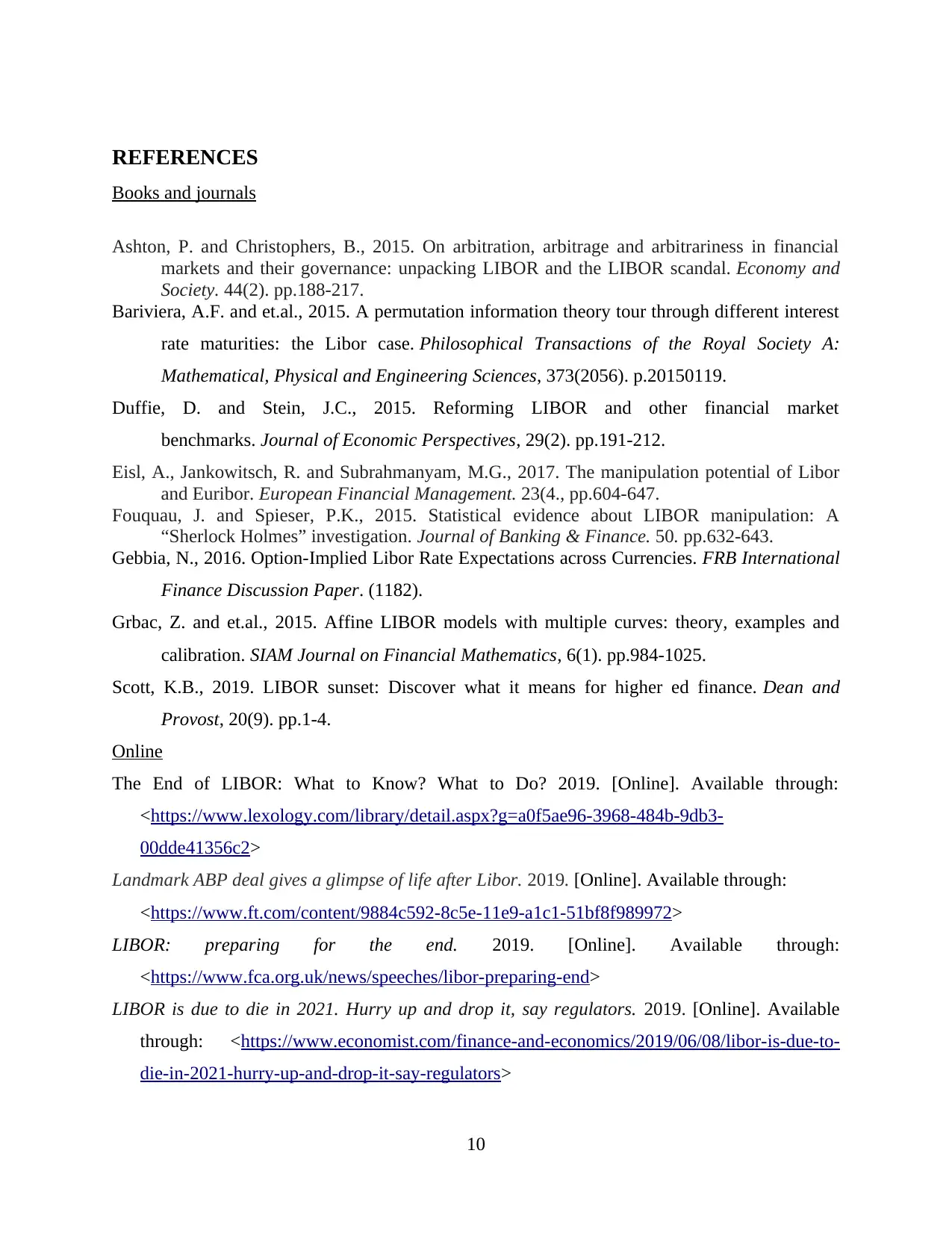
REFERENCES
Books and journals
Ashton, P. and Christophers, B., 2015. On arbitration, arbitrage and arbitrariness in financial
markets and their governance: unpacking LIBOR and the LIBOR scandal. Economy and
Society. 44(2). pp.188-217.
Bariviera, A.F. and et.al., 2015. A permutation information theory tour through different interest
rate maturities: the Libor case. Philosophical Transactions of the Royal Society A:
Mathematical, Physical and Engineering Sciences, 373(2056). p.20150119.
Duffie, D. and Stein, J.C., 2015. Reforming LIBOR and other financial market
benchmarks. Journal of Economic Perspectives, 29(2). pp.191-212.
Eisl, A., Jankowitsch, R. and Subrahmanyam, M.G., 2017. The manipulation potential of Libor
and Euribor. European Financial Management. 23(4., pp.604-647.
Fouquau, J. and Spieser, P.K., 2015. Statistical evidence about LIBOR manipulation: A
“Sherlock Holmes” investigation. Journal of Banking & Finance. 50. pp.632-643.
Gebbia, N., 2016. Option-Implied Libor Rate Expectations across Currencies. FRB International
Finance Discussion Paper. (1182).
Grbac, Z. and et.al., 2015. Affine LIBOR models with multiple curves: theory, examples and
calibration. SIAM Journal on Financial Mathematics, 6(1). pp.984-1025.
Scott, K.B., 2019. LIBOR sunset: Discover what it means for higher ed finance. Dean and
Provost, 20(9). pp.1-4.
Online
The End of LIBOR: What to Know? What to Do? 2019. [Online]. Available through:
<https://www.lexology.com/library/detail.aspx?g=a0f5ae96-3968-484b-9db3-
00dde41356c2>
Landmark ABP deal gives a glimpse of life after Libor. 2019. [Online]. Available through:
<https://www.ft.com/content/9884c592-8c5e-11e9-a1c1-51bf8f989972>
LIBOR: preparing for the end. 2019. [Online]. Available through:
<https://www.fca.org.uk/news/speeches/libor-preparing-end>
LIBOR is due to die in 2021. Hurry up and drop it, say regulators. 2019. [Online]. Available
through: <https://www.economist.com/finance-and-economics/2019/06/08/libor-is-due-to-
die-in-2021-hurry-up-and-drop-it-say-regulators>
10
Books and journals
Ashton, P. and Christophers, B., 2015. On arbitration, arbitrage and arbitrariness in financial
markets and their governance: unpacking LIBOR and the LIBOR scandal. Economy and
Society. 44(2). pp.188-217.
Bariviera, A.F. and et.al., 2015. A permutation information theory tour through different interest
rate maturities: the Libor case. Philosophical Transactions of the Royal Society A:
Mathematical, Physical and Engineering Sciences, 373(2056). p.20150119.
Duffie, D. and Stein, J.C., 2015. Reforming LIBOR and other financial market
benchmarks. Journal of Economic Perspectives, 29(2). pp.191-212.
Eisl, A., Jankowitsch, R. and Subrahmanyam, M.G., 2017. The manipulation potential of Libor
and Euribor. European Financial Management. 23(4., pp.604-647.
Fouquau, J. and Spieser, P.K., 2015. Statistical evidence about LIBOR manipulation: A
“Sherlock Holmes” investigation. Journal of Banking & Finance. 50. pp.632-643.
Gebbia, N., 2016. Option-Implied Libor Rate Expectations across Currencies. FRB International
Finance Discussion Paper. (1182).
Grbac, Z. and et.al., 2015. Affine LIBOR models with multiple curves: theory, examples and
calibration. SIAM Journal on Financial Mathematics, 6(1). pp.984-1025.
Scott, K.B., 2019. LIBOR sunset: Discover what it means for higher ed finance. Dean and
Provost, 20(9). pp.1-4.
Online
The End of LIBOR: What to Know? What to Do? 2019. [Online]. Available through:
<https://www.lexology.com/library/detail.aspx?g=a0f5ae96-3968-484b-9db3-
00dde41356c2>
Landmark ABP deal gives a glimpse of life after Libor. 2019. [Online]. Available through:
<https://www.ft.com/content/9884c592-8c5e-11e9-a1c1-51bf8f989972>
LIBOR: preparing for the end. 2019. [Online]. Available through:
<https://www.fca.org.uk/news/speeches/libor-preparing-end>
LIBOR is due to die in 2021. Hurry up and drop it, say regulators. 2019. [Online]. Available
through: <https://www.economist.com/finance-and-economics/2019/06/08/libor-is-due-to-
die-in-2021-hurry-up-and-drop-it-say-regulators>
10
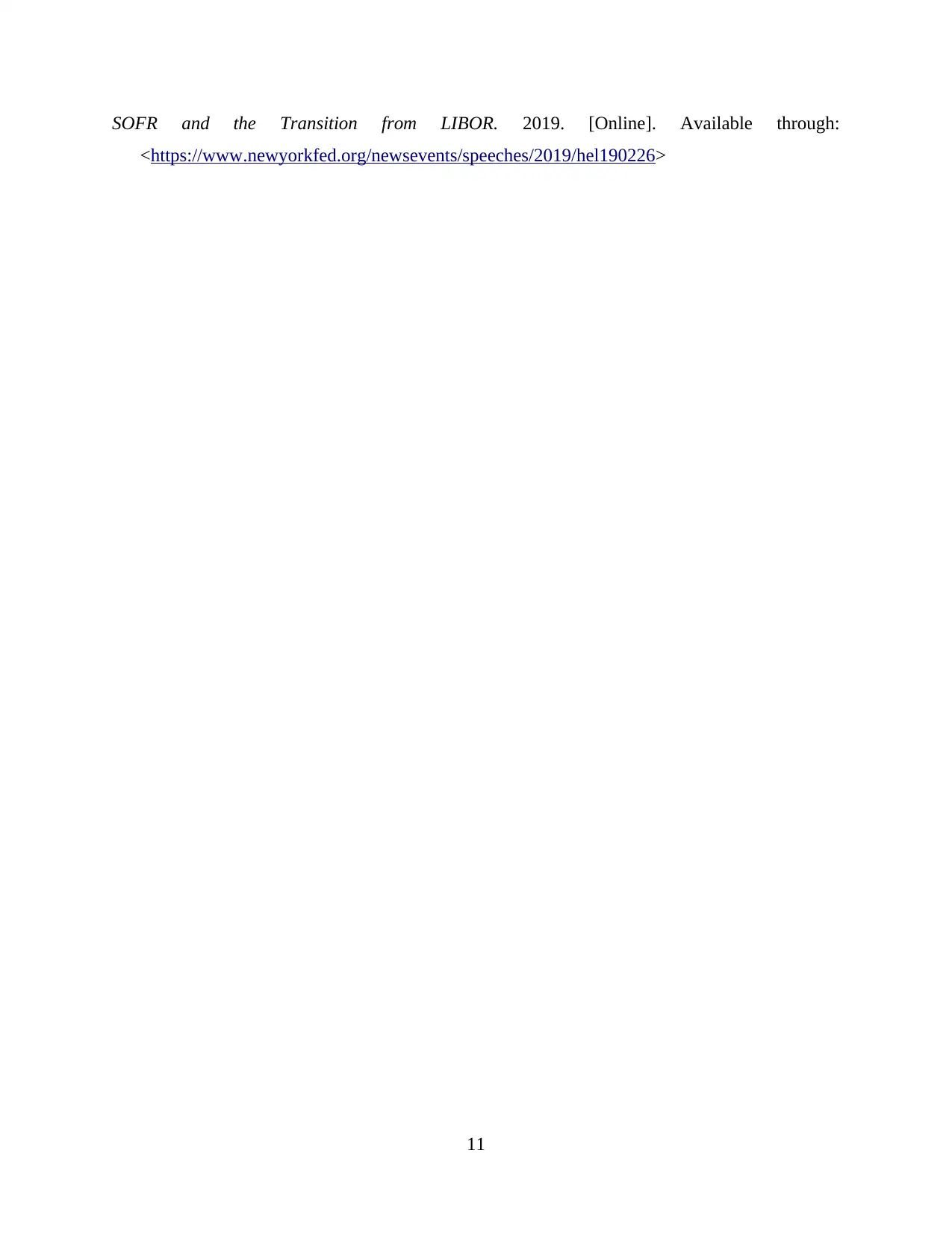
SOFR and the Transition from LIBOR. 2019. [Online]. Available through:
<https://www.newyorkfed.org/newsevents/speeches/2019/hel190226>
11
<https://www.newyorkfed.org/newsevents/speeches/2019/hel190226>
11
1 out of 12
Your All-in-One AI-Powered Toolkit for Academic Success.
+13062052269
info@desklib.com
Available 24*7 on WhatsApp / Email
![[object Object]](/_next/static/media/star-bottom.7253800d.svg)
Unlock your academic potential
© 2024 | Zucol Services PVT LTD | All rights reserved.


